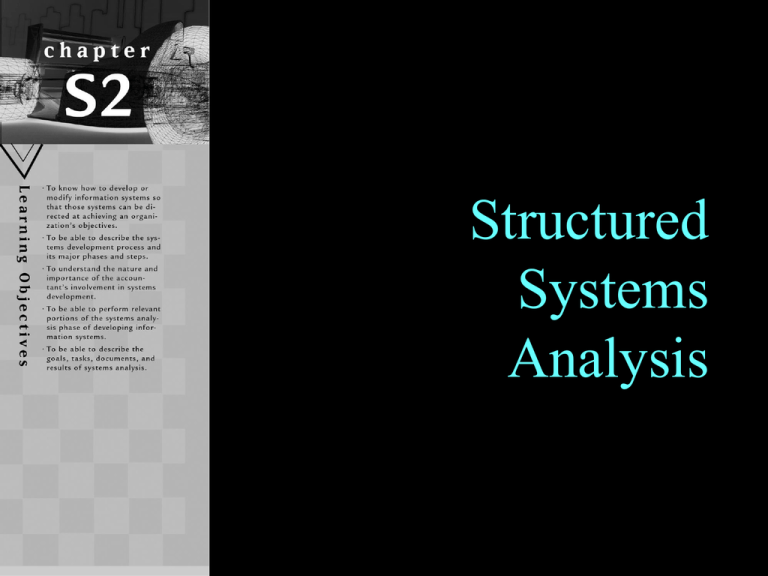Chapter 2
advertisement

Structured Systems Analysis 1 Learning Objectives • • • • • To know how to develop or modify information systems so that those systems can be directed at achieving an organization’s objectives. To be able to describe the systems development process and its major phases and steps. To understand the nature and importance of the accountant’s involvement in systems development. To be able to perform relevant portions of the systems analysis phase of developing information systems. To be able to describe the goals, tasks, documents, and results of systems analysis. Structured Systems Analysis Focus of this Chapter • Controlling the systems development process. • Business Process Reengineering. • Change Management. • Accountant’s involvement with systems development. • Systems survey. • Structured systems analysis. 3 Controlling the Systems Development Process • Systems development objectives: – To develop an information system that satisfies an organization’s informational and operational needs (product-oriented objective). – To develop an information system in an efficient and effective manner (process oriented objective). • Quality Assurance. • Systems development methodology. 4 Quality Assurance (QA) • Quality assurance (QA) addresses the prevention and detection of errors, especially defects in software that may occur during the system development process. • Sources of Guidance for QA: – ISO 9000-3 . – Capability Maturity Model (CMM) developed by the Software Engineering Institute (SEI) at Carnegie Mellon University. 5 ISO 9000-3 6 Capability Maturity Model (CMM) • The Capability Maturity Model® (SWCMM®) for Software is a model that helps organizations evaluate the effectiveness of their software development processes and identify the key practices required to increase the maturity of those processes. 7 Capability Maturity Model (CMM) 8 Systems Development Methodology • A systems development methodology (also known as systems development life cycle (SDLC) methodology) is a formalized, standardized, documented set of activities used to manage a systems development project. • The methodology should be followed along with the processes recommended in ISO 9000-3 and the SW-CMM. 9 Systems Development Methodology 10 The Systems Development Life Cycle 11 Four Phases of Systems Development 12 Business Process Reengineering (BPR) • Business process reengineering (BPR) (or simply reengineering) reflects a fundamental and oftentimes radical redesign of existing business processes. • The goal is to successfully achieve remarkable improvements in the performance of an organization, both qualitative and quantitative. 13 Four BPR concepts: 1. 2. 3. 4. A fundamental rethinking of business processes. Radical redesign relies on a fresh-start, clean-slate approach to examining an organization’s business processes. Reengineering focuses on end-to-end business processes rather than on the individual activities that comprise the processes. Achieving remarkable improvements in performance measurements is related to the preceding two elements. 14 Making BPR Successful • Organize around outcomes, not tasks. • Have those who need the results of a process perform the process. • Integrate the processing of information into the work process that produces the information. • Treat geographically dispersed resources as though they were centralized. • Link parallel activities instead of integrating their results. • Put the decision point where the work is performed, and build controls into the process. • Capture information once and at the source. 15 Change Management • Most humans resist change. • The introduction or modification of an information system is one of the most far-reaching changes for an organization. • Management must find ways to overcome the dysfunctional behaviors brought on by the implementation of a new information system. • People are concerned with actual and perceived changes in work procedures and relationships, corporate culture, and organizational hierarchy that these changes bring. • We must involve the users in the systems change process. • Successful, large IT change projects—especially those involving enterprise systems—must be driven by the business processes and managed by the business process owners. • IT assists with, but does not drive, the change process. 16 Accountant’s Involvement with Systems Development • Most accountants are uniquely qualified also to participate in the broader category of systems development because they: – May be among the few people in an organization who can combine knowledge of IT, business, accounting, and internal control, as well as behavior and communications, to ensure that new systems meet the needs of the user and possess adequate internal controls. – Have specialized skills, such as accounting and auditing, that can be applied to the development project. – Possess a broad understanding of an organization’s business processes. 17 Systems Survey • The systems survey is the first step in the development of a particular system. • The systems survey is conducted to investigate information systems problems and to decide on a course of action. • The systems survey, often called a feasibility study or preliminary feasibility study, is a set of procedures conducted to determine the feasibility of a potential systems development project and to prepare a systems development plan for projects considered feasible. 18 Systems Survey Goals 1. Determine the nature and the extent of each reported problem. 2. Determine the scope of the problem. 3. Propose a course of action that might solve the problem. 4. Determine the feasibility of any proposed development. – Is there a technically, operationally, and economically feasible solution to the problem? 5. Devise a detailed plan for conducting the analysis step. 6. Develop a summary plan for the entire development project. 19 Systems Survey Tasks and Documents 20 Structured Systems Analysis • Structured systems analysis reflects a set of procedures conducted to generate the specifications for a new (or modified) information system or subsystem. • Systems analysis is often called structured systems analysis when certain structured tools and techniques, such as data flow diagrams (DFDs), are used in conducting the analysis. 21 Systems Analysis Goals 1. Define the problem precisely. 2. Devise alternative designs (solutions). 3. Choose and justify one of these alternative design solutions. 4. Develop logical specifications for the selected design. 5. Develop the physical requirements for the selected design. 6. Develop the budget for the next two systems development phases (systems design, Chapter S3, and systems implementation, Chapter S4). 22 Systems Analysis Tasks and Documents 23 The Analysis Deliverable: The Approved Systems Analysis Document • Figure S2.3 has two outputs: the logical specification and the physical requirements. • A third output, a budget and schedule, is implied, but not shown. • All three systems analysis outputs are generally part of a single approved systems analysis document—the final output of systems analysis. 24 Approved Systems Analysis Document 25 Triggering Systems Analysis • If management (or the IT steering committee) approves the project for further systems development, systems analysis follows the systems survey. • The decision is based on the approved feasibility document and other information. 26 Study and Document the Current Physical System • The team reads and interprets existing documentation, such as data flow diagrams and systems flowcharts, corrects that documentation as needed or prepares new documentation. – Verify the accuracy and reasonableness of information already gathered. – Then solidify understanding of the existing system by gathering, analyzing, and documenting additional information to specify the new system in detail. • While studying the current physical environment (gathering and analyzing facts), the analysis team completes the systems analysis documentation. – Systems analysis documentation includes: memos summarizing interviews and observations, charts, tables, and graphs, completed questionnaires (or summaries of results), flowcharts, physical data flow diagrams, and organization charts. 27 Extract and Document the Current Logical Equivalent • The analyst might proceed in any one of three directions: 1. 2. 3. Users would like the analyst to leap immediately to the future physical system (bubble 2.4 in Figure S2.3, page 49). The users, unfortunately, do not have a clear idea of what the new system should be, and vague ideas are not an adequate basis for design and implementation. The analyst, concerned with design features, alternative implementations, and the costs and benefits of those alternatives, would like to start with the future logical system (bubble 2.3 in Figure S2.3). A third alternative, following the steps in Figure S2.3, lead to successful development efforts: • • • • Study the current physical system (bubble 2.1). Document the current logical system (bubble 2.2). Define the future logical system (bubble 2.3). Design the future physical system (bubble 2.4). 28 Create a Current Logical DFD • The analyst removes all the physical elements from the current physical data flow diagram and produces a current logical data flow diagram. • Figure S2.5 is the Causeway current logical DFD. Exhibit S2.6 (page 54) is the narrative description of that system. • Let’s review both before we go on. 29 Causeway Logical DFD 30 Define Future Logical System • Define user requirements for the new/modified system. • Rank those requirements in order of importance. • One expert proposes that user requirements be placed in three categories: 1. Critical features without which the system would be unusable. 2. Features without which the users would be greatly affected but still willing to use the system. 3. Features that users would love to have but would not miss if they were not available. 31 Define Future Logical System • Results of analysis: Causeway will permit customers to receive bills and make electronic payments with an electronic bill presentment and payment system. • Compare the differences between the current logical system (Figure S2.5, page 53), with the future logical system (Figure S2.6). 32 Future Logical System 33 Steps to Derive the Future Logical System • Three steps to derive a future logical system from a current logical DFD: 1. Add new activities. 2. Remodel existing activities. 3. Add or change control activities. • See text pages 54-56 for discussion. 34 Design Alternative Future Physical Systems • How the future physical system might be derived from the future logical system (Figure S2.6): 1. Decide which processes will be manual and which will be automated. • • Bubble 1.0 would probably be partly manual and partly automated. Bubble 2.0 could be partly manual and partly automated. 2. Decide which processes will begin immediately upon occurrence of an event and which will operate only periodically. • • Bubble 1.0 might contain steps that are completed in the immediate mode. Bubble 2.0 might contain steps that are performed in the periodic mode. 3. Complete specifications for the future physical system. • Exhibit S2.7 contains the Causeway future physical system specifications. 35 Design Alternative Future Physical Systems • Here are a few alternatives to the specifications for bubble 1.0 in Exhibit S2.7: – Alternative technologies. • Under the current design Causeway hosts its own bill payment site—the biller direct model. • However, Causeway could use a third party—such as CheckFree—to host the bill payment site. – Alternative modes. • Immediate mode. • Periodic mode. 36 Select the Best Alternative Physical System • Selection involves two decisions: 1. The analysis team must decide which alternative system to recommend to the users and management. – Conduct a cost/effectiveness study which includes: – Cost/Benefit analysis. – Effectiveness analysis. 2. Given the analysis team’s recommendation, the firm’s management, usually the IT steering committee, must decide whether to undertake further development. – If further development is chosen, management must decide which alternative system should be developed. • • This is often an iterative process. The analysis team and the IT steering committee should agree on the best alternative. – The IT steering committee still has the option of making no changes to the existing system (do nothing). 37 Cost/Benefit Analysis 1. Estimate costs. – Direct costs and indirect costs. – Tangible costs and intangible costs. – Review recurring verses nonrecurring costs. 2. Estimate benefits. • • Direct benefits and indirect benefits. Tangible benefits and intangible benefits. 38 Effectiveness Analysis • Steps: 1. List all relevant criteria, including costs and benefits used in the cost/benefit analysis. 2. Include intangible items for which monetary costs and benefits could not be estimated during the cost/benefit study. 3. The users and the analysts jointly assign subjective rankings to each criterion for each alternative. 4. The team then ranks the alternatives by summarizing the ratings. 5. Recommend an alternative to the user, to management, and to the IT steering committee. • • Where one alternative is not clearly superior, the users and analysts must agree on an alternative to be proposed to the IT steering committee. Information about all alternatives, along with the development team’s recommendation, is presented to the IT steering committee. 39 Complete and Package the Approved Systems Analysis Document • First analysis deliverable: logical specification. – – – – Executive summary. Process description. Information requirements. Miscellaneous functions. • Second analysis deliverable: physical requirements. – Hardware. – Functional layouts of inquiry screens and reports. • Third analysis deliverable: budget and schedules. – Budget from the cost benefit analysis. – Schedules setting time limits on development activities. • Final step is to obtain approvals. – Obtain signoffs from users, information services, internal auditors and management. 40





